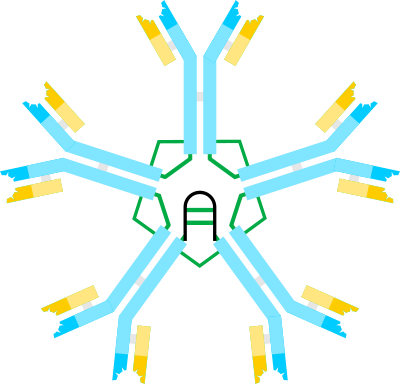WBR0681
| Author | [[PageAuthor::Rim Halaby, M.D. [1]]] |
|---|---|
| Exam Type | ExamType::USMLE Step 1 |
| Main Category | MainCategory::Immunology |
| Sub Category | SubCategory::General Principles |
| Prompt | [[Prompt::A 1 year old boy is brought by his mother for recurrent infections. Following appropriate work-up, the patient is found to have very high serum concentration of one immunoglobulin class that normally exists in the form shown in the image below. The patient also has deficient serum concentrations of all other immunoglobulin classes. Which of the following best characterizes the patient's condition? |
| Answer A | AnswerA::Defect in B-cell maturation |
| Answer A Explanation | AnswerAExp::Common variable immunodeficiency (CVID) is due to a defect in B-cell maturation. |
| Answer B | AnswerB::Inability of T cells to reorganize actin cytoskeleton |
| Answer B Explanation | AnswerBExp::Wiskott-Aldrich syndrome is characterized by the inability of T cells to reorganize actin cytoskeleton. |
| Answer C | AnswerC::Failure of Th1 cells to produce IFN-gamma |
| Answer C Explanation | AnswerCExp::Hyper-IgE syndrome is characterized by the failure of Th1 cells to produce IFN-gamma. |
| Answer D | AnswerD::Defect of the BTK gene |
| Answer D Explanation | AnswerDExp::X-linked (Bruton's) agammaglobulinemia is characterized by a defective BTK gene. |
| Answer E | AnswerE::Defective CD40L on helper T cells |
| Answer E Explanation | AnswerEExp::Hyper-IgM syndrome is characterized by defective CD40L on helper T cells |
| Right Answer | RightAnswer::E |
| Explanation | [[Explanation::The patient has elevated levels of IgM, which is a pentamer that is produced in the immediate response against pathogens. The shape of IgM is important to allow it to maximally trap antigens. Given the patient's elevated IgM, he most likely has hyper IgM syndrome, which is commonly due to a defective CD40L on helper T cells that prevents immunoglobulin class switching, leading to a deficiency in all other classes of immunoglobulin and high serum concentration of IgM. Patients with hyper IgM syndrome typically complain of recurrent pyogenic infections due to inability to mount an appropriate immune response.
Educational Objective: IgM is a pentamer. It is increased in hyper IgM syndrome, that is commonly caused by a defective CD40L on helper T cells. |
| Approved | Approved::No |
| Keyword | WBRKeyword::hyper, WBRKeyword::IgM, WBRKeyword::hyper-IgM, WBRKeyword::recurrent, WBRKeyword::infection, WBRKeyword::infections, WBRKeyword::CD40L, WBRKeyword::class, WBRKeyword::switching, WBRKeyword::immunoglobulin, WBRKeyword::pentamer |
| Linked Question | Linked:: |
| Order in Linked Questions | LinkedOrder:: |
